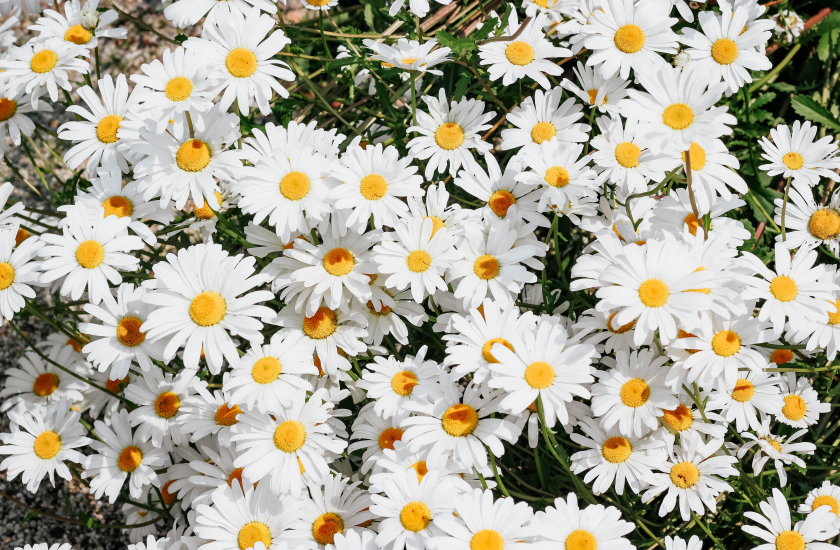Daisies
Our Brochures
Contact Us
Social Media


- Family: Asteraceae.
- Genus: Bellis (common daisies) and Leucanthemum (oxeye daisies).
- Blooming Season: Spring and summer, though some varieties can bloom in other seasons.
- Height: They vary between 15 and 60 cm depending on the variety.
Daisies varieties
- Common Daisy (Bellis perennis): Also known as the English daisy.
- Oxeye Daisy (Leucanthemum vulgare): Characterized by its larger flowers and taller stem.
- African Daisy (Osteospermum): Notable for a wide range of vibrant colors.
- Paris Daisy (Chrysanthemum frutescens): Features white flowers with a prominent yellow center.
Common Uses
- Gardening: Widely used in gardens and as ornamental plants due to their beauty and ease of cultivation.
- Floral Arrangements: Common in bouquets and floral arrangements, often paired with other flowers.
- Culinary: The young leaves and petals can be used in salads.
The production process Daisies
- Seed/Cutting Selection:
Seeds: High-quality seeds are selected to ensure good germination.
Cuttings: In some varieties, cuttings from healthy mother plants can be used. - Soil Preparation:
Conditioning: The soil must be well prepared, ensuring good drainage to prevent waterlogging.
Fertilization: Appropriate fertilizers are applied to provide the necessary nutrients. - Planting:
Timing: Generally planted in spring or autumn, depending on the climate and the daisy variety.
Spacing: Adequate spacing between plants should be maintained to allow good growth. - Growth:
Irrigation: Providing consistent but not excessive watering is vital.
Pest and Disease Control: Implementing preventive and controlled measures to protect the plants.
- Harvest:
Timing: Harvesting is done when the flowers are at their optimum point, generally just before they are fully open.
Method: It is done manually to avoid damaging the flowers. - Post-harvest:
Sorting: The flowers are sorted based on their quality and size.
Packaging: They are packaged carefully to prevent damage during transportation. - Marketing:
Distribution: The flowers are distributed to florists, supermarkets, and other points of sale.
Sales: They are sold both locally and internationally, depending on the scale of the production.
It is important to note that throughout the process, attention should be paid to the climatic and soil conditions, as well as the specific needs of the daisy variety being cultivated.
Places Where It Is Grown
- Daisies are cultivated in various parts of the world, being especially prevalent in regions with temperate climates. Here is a general overview of the areas where they are commonly grown:
- Europe: Daisies are found in the wild and in gardens throughout the continent, being very common in countries such as the UK, France, Germany, among others.
- North America: In the USA and Canada, they are highly prized in both domestic gardens and public parks.
- Asia: In countries such as Japan and China, daisies are valued and are used in both traditional and modern gardening.
- Africa: Although not as prevalent, they can also be found in various regions of Africa, especially in designed gardens and landscapes.
- Australia and New Zealand: In these regions, daisies have found a place in gardens and green areas, being especially popular during the spring and summer.
- Latin America: In countries such as Mexico, Colombia, Argentina, among others, daisies are popular in gardening and can also be found in the wild in some regions.
- Daisies are quite adaptable and can grow in a variety of soils as long as they have sufficient sunlight and the soil has good drainage. Their hardiness and beauty make them a popular choice for gardeners around the world.
Medicinal Uses
- Remedies: Traditionally used in home remedies to treat ailments such as bronchitis.
- Infusions: The flowers can be used to make infusions that help alleviate cold symptoms. Nutritional Components
- Although not commonly consumed, it contains:
- Vitamins: Contains vitamin C and other vitamins in small quantities.
- Minerals: Provides minerals such as potassium.
